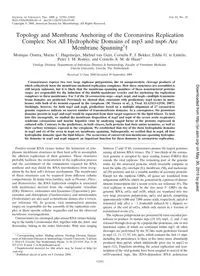
2008 Topology and Membrane Anchoring of the Coronavirus Replication Complex_ Not All Hydrophobic Domains of nsp3 and nsp PDF
Preview 2008 Topology and Membrane Anchoring of the Coronavirus Replication Complex_ Not All Hydrophobic Domains of nsp3 and nsp
JOURNAL OF VIROLOGY, Dec. 2008, p. 12392–12405 Vol. 82, No. 24 0022-538X/08/$08.00�0 doi:10.1128/JVI.01219-08 Copyright © 2008, American Society for Microbiology. All Rights Reserved. Topology and Membrane Anchoring of the Coronavirus Replication Complex: Not All Hydrophobic Domains of nsp3 and nsp6 Are Membrane Spanning�† Monique Oostra, Marne C. Hagemeijer, Michiel van Gent, Cornelis P. J. Bekker, Eddie G. te Lintelo, Peter J. M. Rottier, and Cornelis A. M. de Haan* Virology Division, Department of Infectious Diseases & Immunology, Faculty of Veterinary Medicine, Utrecht University, Utrecht, The Netherlands Received 12 June 2008/Accepted 30 September 2008 Coronaviruses express two very large replicase polyproteins, the 16 autoproteolytic cleavage products of which collectively form the membrane-anchored replication complexes. How these structures are assembled is still largely unknown, but it is likely that the membrane-spanning members of these nonstructural proteins (nsps) are responsible for the induction of the double-membrane vesicles and for anchoring the replication complexes to these membranes. For 3 of the 16 coronavirus nsps—nsp3, nsp4, and nsp6—multiple transmem- brane domains are predicted. Previously we showed that, consistent with predictions, nsp4 occurs in mem- branes with both of its termini exposed in the cytoplasm (M. Oostra et al., J. Virol. 81:12323-12336, 2007). Strikingly, however, for both nsp3 and nsp6, predictions based on a multiple alignment of 27 coronavirus genome sequences indicate an uneven number of transmembrane domains. As a consequence, the proteinase domains present in nsp3 and nsp5 would be separated from their target sequences by the lipid bilayer. To look into this incongruity, we studied the membrane disposition of nsp3 and nsp6 of the severe acute respiratory syndrome coronavirus and murine hepatitis virus by analyzing tagged forms of the proteins expressed in cultured cells. Contrary to the predictions, in both viruses, both proteins had their amino terminus, as well as their carboxy terminus, exposed in the cytoplasm. We established that two of the three hydrophobic domains in nsp3 and six of the seven in nsp6 are membrane spanning. Subsequently, we verified that in nsp4, all four hydrophobic domains span the lipid bilayer. The occurrence of conserved non-membrane-spanning hydropho- bic domains in nsp3 and nsp6 suggests an important function for these domains in coronavirus replication. Positive-strand RNA viruses induce the formation of cyto- plasmic membrane structures in their host cells to accomplish the efficient replication of their genomes. These structures probably facilitate the orchestration of the replication process and the recruitment of the components required for RNA synthesis and may shield the RNA intermediates from recog- nition by the host cell’s defense mechanisms. The membranes of these structures can be acquired from different cellular compartments. In many virus families, such as Picorna-, Flavi-, and Bromoviridae, the RNA replication complex is associated with membranes derived from the endoplasmic reticulum (ER). However, endosomes and lysosomes (Togaviridae), per- oxisomes and chloroplasts (Tombusviridae), and mitochondria (Nodaviridae) are also used as membrane donors (for a review, see reference 44). In general, viral nonstructural proteins (nsps) are responsible for the assembly of the replication com- plex at these specific cellular organelles and for the observed membrane rearrangements. Coronaviruses are enveloped, plus-strand RNA viruses belong- ing to the family Coronaviridae that, together with the Arteri- and Roniviridae, belong to the order Nidovirales. With sizes ranging between 27 and 32 kb, coronaviruses possess the largest genomes among all known RNA viruses. The 5� two-thirds of the corona- viral genome is occupied by open reading frames (ORFs) that encode the viral replicase. The remaining part of the genome codes for the structural proteins, which invariably comprise at least the spike (S), envelope (E), membrane (M), and nucleocap- sid (N) proteins, and for a variable number of accessory proteins. Except for the replicase ORFs, all genes are translated from subgenomic mRNAs, which are generated by a process of discon- tinuous transcription (for a recent review, see reference 45). The viral replicase is encoded by the two most 5� ORFs on the genomic RNA, orf1a and orf1b, which are translated into two very large precursor polyproteins, pp1a and pp1ab, comprising approximately 4,000 and 7,000 amino acids, respectively. pp1ab is translated only after a �1 frameshift induced by a slippery se- quence at the end of orf1a, which only occurs in a fraction of translational events (5). The replicase polyproteins are processed by virus-encoded pro- teinases to produce 16 mature nsps (19, 63). nsp1, -2, and -3 are released through cleavage by a papain-like proteinase, one or two functional copies of which are contained within nsp3; all other cleavages are performed by the 3C-like main proteinase located in nsp5 (2, 11, 17, 55, 64). pp1a, which contains the first 11 nsps, including the proteinases, is three to five times more abundantly produced than pp1ab, which additionally gives rise to nsp12 to nsp16 (13). Functions involving the actual replication and tran- scription of the viral genome have been assigned to several of the orf1b-encoded nsps, like RNA-dependent RNA polymerase * Corresponding author. Mailing address: Virology Division, Depart- ment of Infectious Diseases & Immunology, Utrecht University, Yalelaan 1, 3584 CL Utrecht, The Netherlands. Phone: 31 30 253 4195. Fax: 31 30 253 6723. E-mail:
